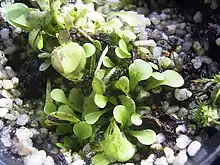Genlisea violacea
Genlisea violacea is a corkscrew plant native to South America.[1]
| Genlisea violacea | |
|---|---|
 | |
| Scientific classification | |
| Kingdom: | Plantae |
| Clade: | Tracheophytes |
| Clade: | Angiosperms |
| Clade: | Eudicots |
| Clade: | Asterids |
| Order: | Lamiales |
| Family: | Lentibulariaceae |
| Genus: | Genlisea |
| Subgenus: | Genlisea subg. Tayloria |
| Species: | G. violacea |
| Binomial name | |
| Genlisea violacea A.St.-Hil. (1833) | |
| Synonyms | |
| |
Physical Appearance
Genlisea violaceae is a small herbaceous perennial plant with a rosette growth habit. The leaves are long, slender, undersoil stolons that trap nematodes and small soil insects resemble corkscrews. Five-petaled flowers resemble viola flowers, which gives the species its name.
Habitat and Distribution
Genlisea violaceae is native to certain regions of South America, including Brazil, Guyana, and Venezuela. It thrives in wetland habitats. These plants are often found growing in acidic or sandy soils with a high water table, which provides them with the necessary moisture for survival.
References
- Saint-Hilaire, A. 1833. Voyage dans le District du Diamans du Brésil 2: 428–432.
Wikimedia Commons has media related to Genlisea violacea.
This article is issued from Wikipedia. The text is licensed under Creative Commons - Attribution - Sharealike. Additional terms may apply for the media files.